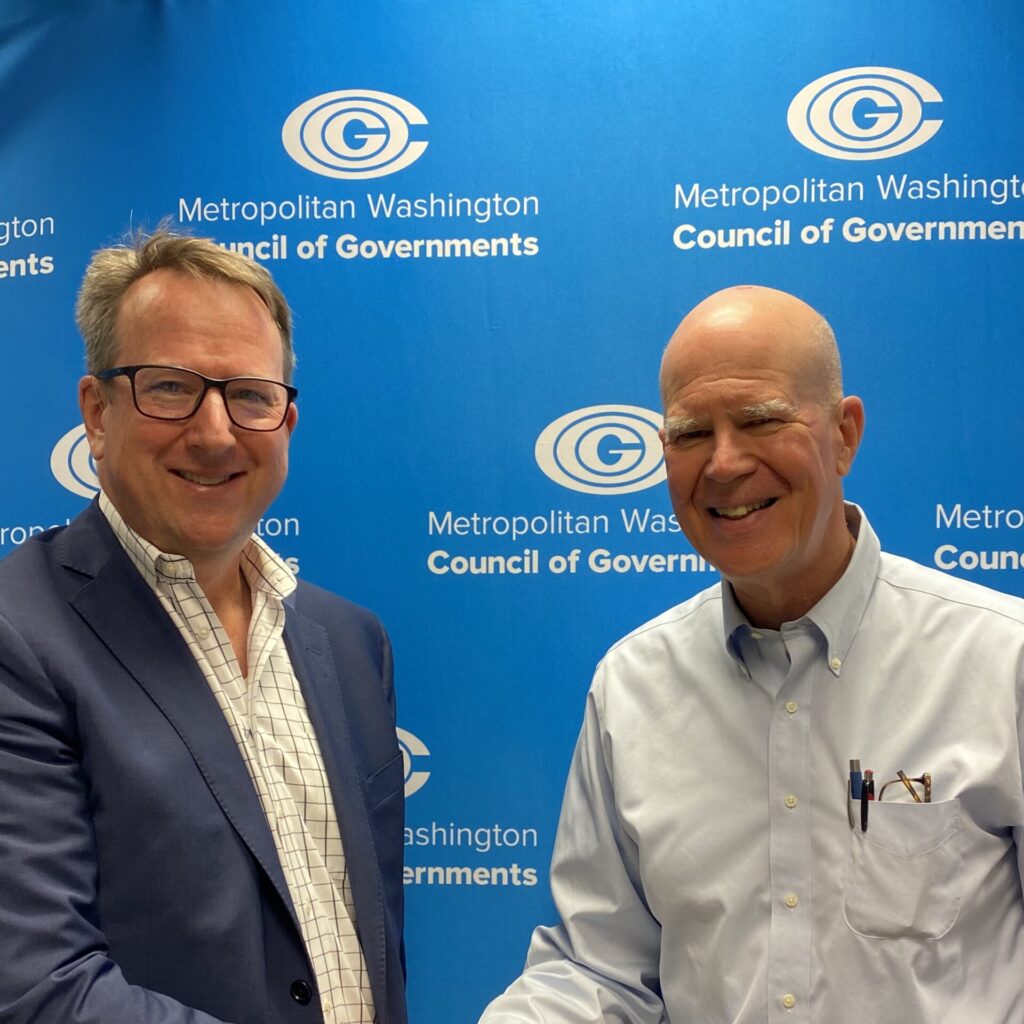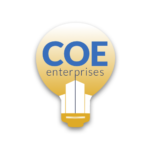

Bio
Chuck Bean, Executive Director of the Metropolitan Washington Council of Governments, is an executive and civic leader with more than 30 years of experience in nonprofits, philanthropy, and government. As executive director, he is responsible for COG’s overall administration and has guided high-level projects for the organization and region, including unified planning priorities for 2030 related to equity, transportation, housing, and climate. Chuck began his tenure in 2012. Chuck has a BA from Macalester College in St. Paul, MN and a MPP from Harvard’s John F. Kennedy School of Public Policy.
Show Notes
- Role as Executive Director of MWCOG- 10 years there leading 125 people in staff in various aspects of planning. Primary liaison of 24 jurisdictions in the DC region. Designated Metropolitan Planning Organization (Transportation Planning Board). (5:45)
- Finding the “win-win” among jurisdictions (7:00)
- Collaborative work among the various jurisdictions in water and transportation (7:30)
Origins and Education
- Grew up in Minnesota (8:10)
- Father a doctor and Mother is a teacher (8:15)
- Father became 18 at end of WW2 and GI bill helped him through Medical School (8:50)
- Methodist Church influence- Iowa progressive influence (10:10)
- Public service opportunity- Traveled to Nicaragua at 17 yrs. old (11:15)
- Volunteer activity with native tribe there during the counter revolution there (12:30)
- Reunited with the people he met them three years later in Costa Rica (13:15)
- Appreciated his path in life (13:50)
- Macalester College– International college (14:00)
- 1970s it was known as a progressive college with “Reader’s Digest” founders as funding sources (14:45)
- Played football there (16:10)
- Political Science- Administrative Behavior (17:10)
- Anthropology interest- has influenced him more recently in his career (17:45)
- Leadership requires sociological and anthropological understanding in government work (18:20)
- Anthropology- Ethnographic interviewing- culture (21:15)
- Harvard Kennedy School (22:00)
- Master in Public Policy program (22:30)
- 150 in his class and 12 of them are still close friends (22:50)
- Went to El Salvador to write his master’s thesis (24:00)
- Client was United Nations
Career Trajectory
- First job- Guatemala (25:00)
- Co-invest Guatemala- Investment promotion (25:30)
- Minister of Finance change impacted their interest in pursuing the initiative’s objectives
- Moved back to NYC after 9 months (26:30)
- Next job was the Department of Social Services in New York City (26:50)
- Welfare reform in the city
- Vocational discernment
- Analyzing people in NY that needed service with spreadsheet modeling (28:00)
- Deciding what location for service need buildings (28:45)
- Got a lead for job from graduate student friend (29:30)
- Eureka Foundation (31:25)
- Fellowship program for Executive Directors of Non-Profit Organizations (31:40)
- What’s your vision for your organization?
- What do you need to learn to run the organization?
- Reverend Ann Johnson in Detroit, MI (33:00)
- Grant from State of Michigan to help people (33:40)
- Helping her to find foundations to help fellows to improve communities (34:00)
- EZEC Foundation (36:30)
- Help empowerment zone directors (36:50)
- $100MM (37:00)
- Governance- Executive Director Diane Bell from Baltimore (37:25)
- Local government
- CDFI origins
- Community
- Conduct of meeting- Private sector usually are short meeting (38:15)
- Public meetings are long and in the evening (38:30)
- Cross sectoral collaboration is challenging (39:30)
- Find commonality in goals (39:50)
- Peer learning conference in Florida planned on 9/11/01- On plane during terrorist attacks (40:30)
- Tense moments that day (41:30)
- Decided to do something to help after 9/11- Joined a new non-profit called the Community Capacity Fund (42:10)
- Connected with MWCOG while at this non-profit in 2002 (43:45)
- Time limited to “invest” the funds to help the communities impacted (44:00)
- Recruited to be Executive Director of Non Profit Roundtable of Greater Washington (44:45)
- Focal point for Non-Profit sector-12% of regional employment base (45:10)
- Economic impact in billions of dollars (45:30)
- Beyond Charity (45:45)
- Work there was being the voice for non-profits in the region
- Worked with COG on Emergency Preparedness and Foreclosure crisis in region (46:45)
- Non profit housing developers (47:15)
- Housing counseling organizations (47:30)
- Philanthropic investments from Freddie Mac and Fannie Mae helped affordable housing crisis (48:00)
COG Leadership
- Overarching Economic Development perspective- GDP of $570B in the region (analogous to the Country of Sweden) (49:00)
- Inclusive Economic Development (49:30)
- Systematically including “everyone” in the region (49:45)
- Disparity is significant (50:15)
- Inclusive Economic Development (49:30)
- Reality Check for Regionalism (51:10)
- Managing the region’s growth- still a regional imperative (51:30)
- 600,000 people join the region each decade approximately (51:45)
- Forecasting jobs, people, and housing (52:10)
- Region not hit as hard during GFE, however, sequestration hit the economy even harder than the country (52:45)
- How to diversify the economy in the region? (53:25)
- Downturn of Metro began in 2015 (53:50)
- $58B behind in regional infrastructure needs including Metro, roads, and other utility needs (54:20)
- Amazon’s HQ2 RFP stimulated significant interest in spending on regional infrastructure needs (55:15)
- 3 sites- one in VA, one in MD and one in DC was a turning point (56:15)
- Olympics bid- 2024 potential- Greater Washington Partnership- Was not successful (57:00)
- 2017 Version of Selling the DC Region for HQ2 sites (59:30)
- Joint letter with Governors and Mayor (59:50)
- Paul Wiedefeld at WMATA (1:00:45)
- Discussion of Metro challenges (1:01:00)
- $500MM more for capital plan (1:01:40)
- Managing the region’s growth- still a regional imperative (51:30)
- Members are local jurisdictions and states (1:02:00)
- Federal Government interface (1:02:30)
- FTA funding- Metro Safety Commission (1:03:00)
- COG took on the process of managing the Metro system (1:03:15)
- Compact among the DC Gov., MD & VA State Legislature and US Congress signed by President (1:03:30)
- Ongoing multi-stakeholder negotiations (1:04:45)
- Getting to Yes, by Roger Fisher and William Ury
- Listening to underlying interests of stakeholders (1:05:20)
- Everyone wins- Metro Safety
- Experience with boards and the value propositions of each board
- What can we do better together? (1:06:40)
- Membership perspective- provide individual value to the respective jurisdictions (1:06:50)
- Cooperative purchasing for members of COG (1:07:10)
- Wants to bring 2X savings by being a member (1:07:30)
- Electric Vehicle infrastructure value proposition to bring member jurisdictions together (1:08:30)
- Monitor 17 million trips a day and how many are cross jurisdictional (1:09:15)
- Vendor leveraging with multiple jurisdiction customers (1:09:45)
- Quotes former AMEX leader- Job of leader is to provide “hope” (1:10:50)
- COG’s data is to be trusted (1:11:15)
- Role of COG is an umpire calling balls and strikes (1:11:30)
- Jobs outpacing housing (1:11:45)
- More housing needed- Need 75,000 units more than forecasted (1:12:20)
- 2018 Meeting- Amazon leader spoke about housing needs (1:12:50)
- Build more housing closer to jobs
- Housing affordability
- Citation of Amazon investing in Amazon Housing Equity Fund (1:15:00)
- New Carrollton Project
- By far the largest corporate investment in affordable housing (1:16:45)
- Catherine Buell (Amazon’s Housing Equity Fund leader)
- Citation of Amazon investing in Amazon Housing Equity Fund (1:15:00)
- Change in 50-60 yrs.- Federal Gov. was over 33% of region’s economy in early 1950s (1:18:45)
- Now Federal Gov. is 11% of regional economy (1:19:30)
- Victor Hoskins of Fairfax County has changed the culture with many jurisdictions (1:19:50)
- Mayor Bowser’s outreach (1:20:20)
- Biotech efforts
- Connected DMV- biotech, quantum computing, hydrogen (1:20:30)
- During pandemic focused on high capacity transit areas (1:21:30)
- Metro, MARC, Amtrak, Purple Line, Bus Rapid Transit (1:21:45)
- 10% of land mass and 55% of economic development (1:22:15)
- “Acupuncture” of job growth in region (1:22:30)
- New 75 nodes- South Fairfax County is part of this (toward Fort Belvoir) for bus rapid transit (1:23:00)
- “Embark Richmond Highway”-Transportation, housing and economic development (jobs) (1:24:00)
- Baltimore has its own COG (Baltimore Metropolitan Commission) (1:25:00)
- Sharing data and infrastructure transportation infrastructure (1:25:10)
- Cooperative purchasing with Baltimore jurisdictions, as well (1:25:30)
- COG’s involvement in the pandemic issues
- State of Commute due to pandemic influences (1:26:20)
- 5 fold increase in telework- 50% trip reduction (1:26:40)
- Transit is slowly rebounding
- Single Occupancy Vehicle increase (1:27:20)
- Metro usage down, but climbing back up (1:27:30)
- Federal workforce impact on downtown activity and Metro ridership (1:29:00)
- Adaptive reuse of office buildings to residential (1:29:50)
- Mega-patterns- Sense of gravity for workforce to come to Downtown or Inner Suburbs may be reduced long term (1:30:30)
- State of Commute due to pandemic influences (1:26:20)
- Transit Oriented Development (Communities) (1:32:00)
- Mixed use- Work/Live (1:32:45)
- Mixed Income- Opportunities for everyone to be closer to jobs
- Front line workers (1:33:00)
- Walkshed on map- radius of one half mile from the transit station (1:34:20)
- Bikeshed- radius of one mile from transit
- Microtransit shed- 18 seater bus for transit which is two mile radius (1:35:10)
- Community Dynamics- (1:36:45)
- Zoning & land allocation need to be reconsidered (1:37:40)
- Missing Middle income affordable (1:38:00)
- COG Involvement in Economic Development (1:39:30)
- Creating conditions for attracting employment to the area (1:40:30)
- Infrastructure improvements primarily (1:40:45)
Personal
- Helping do gooders do better (1:41:00)
- Facilitated Leadership (1:41:20)
- Leaders among leaders (1:41:45)
- Giving back
- Supporting Native American Historian (1:42:30)
- History and Future of Region (1:42:50)
- Very few people know about native history in the region (1:43:40)
- Chesapeake, James Michener (1:44:30)
- Loss- Going to Guatemala after graduate school (1:45:00)
- Pivots made by people to new opportunities through his network (1:46:20)
- Win- Confluence on HQ2, First unified Metro funding (1:47:00)
- Region United- Equity emphasis areas connecting them to transit (1:47:30)
- Reduction in greenhouse gas in region (1:47:50)
- Ron Terwilliger is an idol (1:48:20)
- Bob Buchanan has been an inspiration for him (1:48:30)
- He crosses sectors in his leadership
- Advice to 25 yr. old self- Find good (pragmatic idealists) people and work with them (1:49:50)
- Nina Albert (GSA), Catherine Buell, Adam Ortiz (EPA) (1:50:20)
- Billboard statement- “Is there another way to get there?” “The DMV is the Place to Be!” (1:51:20)
Postscript
- Michael Grein offers his perspectives of the conversation (1:53:20)
- Background and experiences shaped his “giving back” approach
- Different steps in his career
- Working together with the regional stakeholders
- Cites Purple Line potential
- Discussion about Amazon’s Affordable Housing initiative
- Brains of the region-
- Grassroots leadership approach
- Cooperative instead of competitive approach
- Analysis of the “roadbumps” in Chuck’s career
- Co-Invest Guatemala debacle to New York City move
- Move from Eureka Foundation and flying on 9/11 impact looking for how he could help
